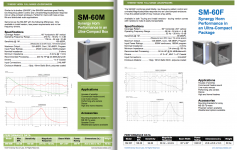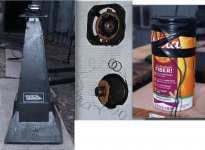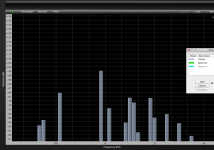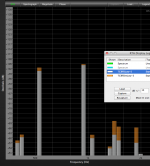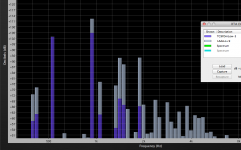This is interesting, but probably belongs in another thread.The TC9FD required more power than the compression driver, but I was amazed at the clarity at the high SPL levels I worked up to. I'm fairly used to the distortion level in speakers telling when to back off, but the TC9FD gave almost no indication of distress until the voice coil melted the glue off the former and it "gaacked" out over about a 1 second period.
I've been using the TC9FD for a few years on several Open Baffle speakers. They are on my current main system, the"Troglodyte" speakers. While I think it's a lovely driver and mate well with a 12 or 15 inch woofer, its main problem is limited SPL. It audibly runs out of steam long before the woofer does. At just moderate listening position levels in my system, the poor little things are screaming. 25ft away the distortion isn't too bad, but up close - ouch! At 2.83 volts, left and right speakers playing, I get 72 dB at the listening position. I've smoked them, too. (Be careful playing them with a 650 watt Crest amp)
Maybe it's the 1L back chamber that helps. Or maybe the horn loading is needed to keep excursion down. I just know that on OB they are nice, but don't play both loud and clean.
The SM60M &F are the DSL units using a 5" coax.Yea, that's just what I was thinking one could do. I'd like to see some data on that design.
DSL has polar data available on their website, but like yours is not available to Mac users.
Attachments
but like yours is not available to Mac users.
So get with the program - Macs are not for engineering work.
Pano,This is interesting, but probably belongs in another thread.
I've been using the TC9FD for a few years on several Open Baffle speakers. They are on my current main system, the"Troglodyte" speakers. While I think it's a lovely driver and mate well with a 12 or 15 inch woofer, its main problem is limited SPL. It audibly runs out of steam long before the woofer does. At just moderate listening position levels in my system, the poor little things are screaming. 25ft away the distortion isn't too bad, but up close - ouch! At 2.83 volts, left and right speakers playing, I get 72 dB at the listening position. I've smoked them, too. (Be careful playing them with a 650 watt Crest amp)
Maybe it's the 1L back chamber that helps. Or maybe the horn loading is needed to keep excursion down. I just know that on OB they are nice, but don't play both loud and clean.
Open baffle anything limits clean output capability
The back chamber of course reduces excursion. The one liter size is not optimal for the horn or TC9FD used in my tests, it just happens that a Metamucil jar with the upper flange cut out was a good fit for it, and a bit under the driver's Vas.
Although this is all somewhat off topic, and I'll be following up after the new year with updates, one bit of information that "slipped through the cracks" in my HF driver evaluation was that the sum of two tones combines to a much higher distortion level than the second harmonic with drivers used on the 13 x 13 degree Maltese conical horn.
Having tested other horns, the same holds true.
Bringing this around to a common driver used in Synergy type horns, the BMS4552 at just 1 watt at both 523 and 932 Hz makes a combined harmonic distortion at 1455 Hz only 3 dB less (almost 70% harmonic distortion) than the lower fundamental, 84 dB at two meters.
Using about 10 watts the TC9FD did over 18 dB more level with very low distortion, though also results in the 1455 Hz sum distortion 6 dB higher than the second harmonic.
The front loaded TC9FD (1 liter chamber) only showed a 2dB increase in the sum distortion, the plot below has the front loaded TC9FD raised by 13 dB to show the difference in distortion at the same drive level.
Although the horn obviously increases output by a huge amount (12dB) the 6 dB increase in the sum distortion compared to front loaded is "very interesting"
Art
Attachments
Last edited:
A cone in WG has the nice hat trick of covering the 500Hz to 6kHz telephone band with one driver. The low HD in this range is one of the main reasons subjectively it sounds so clean. Synergies all have a limitation of how high one can get the mids to go due to the band pass injection ports limiting the upper to circa 1.2kHz hence the compression driver has to be crossed typically lower than optimum. Making the compression driver handle 1.2kHz to 20kHz is a lot to ask I think.
I cross mine at 2800Hz. Anyway, I think I'd rather have a crossover in the telephone band than all the HF breakup of a cone above it (not that I've compared A/B equivalent).
Besides, I'm pretty sure you wouldn't have been able to tell by ear (or eye, for that matter) where my crossover is until I just told you! A well-done synergy sounds like one driver, no matter where or how close you sit or stand.
Nate - I have been thinking of making my measurement software available as public domain. The problem is that I have had nothing but problems with distribution of the exe and dll files in the past. Would you be interested in working with me to sort of the problems with a view to eventual release of the software?
Then if that works it would be great if I could get the web database to allow for people to import there own data. I am aware of web database design, but I don't have enough expertise to do this myself. Maybe someone out there does and could help.
If all this works out then I could offer up my crossover design tool that I used to make all my designs since I won't be using it anymore.
For sure! I'm not sure what I could do to help but let me know.
Yes, of course, but it is hard to know what DLLs are required. That's because the calculations are all done in FORTRAN and the dlls for this are virtually never on the target system. My EXE calls my DLLs, which call other DLLs for the FORTRAN and then more deeply nested DLLs that contain the common FORTRAN run time. There can be DLLs four to five deep and there can be several of these. Miss one and the program crashes.
There are programs can trace all DLL dependencies and these helped me before, but they can be tedious to use.
There are programs can trace all DLL dependencies and these helped me before, but they can be tedious to use.
Last edited:
There are Fortran development platforms that have the option to make "production" executable install files that then make sure all necessary dll's and configuration files and .h etc files are all there. Makes for a much more fool proof distribution. When compiling, choose the option to make distributable self install files.
The highest performing Fortran compiler was the Intel Fortran. The most comprehensive environment for making fool proof distros is Digital Fortran. Make the dll in Intel then make the distro package in Digital or even MS C++ Dev environment.
The highest performing Fortran compiler was the Intel Fortran. The most comprehensive environment for making fool proof distros is Digital Fortran. Make the dll in Intel then make the distro package in Digital or even MS C++ Dev environment.
Last edited:
Art:
Seems like the BMS is being tasked pretty hard- both stimulus frequencies are below recommended 1kHz XO, and it's a small annular diaphragm model. I suspect you'd see very different results with something like a JBL 2426 or other large-diaphragm 1" exit drivers- interesting test nonetheless.
Also interesting that the cone has lower distortion direct radiating than via the horn at small outputs. Perhaps the cone can't handle the higher pressure at the throat, even at reasonable drive levels? Possible that there is some coupling misbehavior driving this?
Would love to see the BMS test with a big format driver, and the Vifa test with a wider lens.
Seems like the BMS is being tasked pretty hard- both stimulus frequencies are below recommended 1kHz XO, and it's a small annular diaphragm model. I suspect you'd see very different results with something like a JBL 2426 or other large-diaphragm 1" exit drivers- interesting test nonetheless.
Also interesting that the cone has lower distortion direct radiating than via the horn at small outputs. Perhaps the cone can't handle the higher pressure at the throat, even at reasonable drive levels? Possible that there is some coupling misbehavior driving this?
Would love to see the BMS test with a big format driver, and the Vifa test with a wider lens.
I cross mine at 2800Hz. Anyway, I think I'd rather have a crossover in the telephone band than all the HF breakup of a cone above it (not that I've compared A/B equivalent).
Besides, I'm pretty sure you wouldn't have been able to tell by ear (or eye, for that matter) where my crossover is until I just told you! A well-done synergy sounds like one driver, no matter where or how close you sit or stand.
Oh cool - I did not know anyone was able to cross that high with a Synergy. My observations so far have noticed mid ports rolling off at 1.2kHz due to distance from compression driver diaphragm being the distance limit given physical size of mid driver and how close ports can be placed near throat of compression driver.
What is the distance from your mid port to the apex?
Thanks! Never seen that one. A 5" coax - cute! Seems to work well in the DSL product.A BMS.
Yes, but mostly the woofer. My crossover high pass is circa 1000 Hz, so the baffle size should not be a loss problem. I doesn't get an air spring to support it, tho.Open baffle anything limits clean output capability!
I'm keen to try the little driver on a horn, the extra sensitivity would be helpful, for sure. Means a big rework of the crossover, but that's expected. Should be fun to try.
What is the distance from your mid port to the apex?

That's the targeted/modeled distance, anyway. The actual/effective distance seems to be a little more, since the quarterwave reflected notch comes in a little lower than HornReponse says. One problem with ports so close in is that the part inside the compression driver gets to be a more significant part of the distance...
I generally have had best luck when I get the ports as close in as I can get them -- which is how I ended up using 2" mid drivers.
1) True, but if a 6 dB crossover was used on the BMS 4552, at 4 watts (instead of 1) you would see the same distortion as shown in post 146. The 4552 needs to be crossed high to be clean.Art:
1)Seems like the BMS is being tasked pretty hard- both stimulus frequencies are below recommended 1kHz XO, and it's a small annular diaphragm model.
2)I suspect you'd see very different results with something like a JBL 2426 or other large-diaphragm 1" exit drivers- interesting test nonetheless.
3)Also interesting that the cone has lower distortion direct radiating than via the horn at small outputs. Perhaps the cone can't handle the higher pressure at the throat, even at reasonable drive levels? Possible that there is some coupling misbehavior driving this?
4)Would love to see the BMS test with a big format driver, and the Vifa test with a wider lens.
2) Not different, just a bit louder. The graph below shows the TC9FD in purple, a DH1A (3" diaphragm, the lowest distortion down low of all the compression drivers I have tested) and the TCFD 3.5" cone, you can see it has way less distortion.
3) Lower distortion % as direct radiator, but far less output. The cone is obviously handling the lesser pressure (lower compression ratio) of the horn way better than compression drivers. It can go another octave lower with good output and low distortion than the test shown below.
4) The large BMS drivers only have a bit more output down low than the DH1A.
I will be starting on some wider horns for the TCFD 3.5" cone later today, but don't expect to post any results until after the new year.
Art
Attachments
JBL 2426J (16 ohms) : even wider than the 8 ohms version. Still 1" ! Clean from 800 Hz to 16/18 K Hz ?
or 18Sound http://www.teamaudio.fr/media/catalog/product/datasheet/eighteen_sound/NSD1480N-8.pdf
?
or 18Sound http://www.teamaudio.fr/media/catalog/product/datasheet/eighteen_sound/NSD1480N-8.pdf
?
There are Fortran development platforms that have the option to make "production" executable install files that then make sure all necessary dll's and configuration files and .h etc files are all there. Makes for a much more fool proof distribution. When compiling, choose the option to make distributable self install files.
The highest performing Fortran compiler was the Intel Fortran. The most comprehensive environment for making fool proof distros is Digital Fortran. Make the dll in Intel then make the distro package in Digital or even MS C++ Dev environment.
I think that you must be out of the FORTRAN loop. ".h" files are for C, FORTRAN uses ".inc".
I only use FORTRAN for the background calculations and use VB.Net for the interface, so the exe is actually in VB.Net. It can create an install file, but the Wizard does not recognize the FORTRAN DLL dependencies, so the install file fails to install all the required DLLs.
Digital FORTRAN became Compaq FORTRAN when Compaq bought Digital. Then Intel bought Compaq FORTAN and now there is only the Intel version in that line of compilers, which runs under MS Visual Studio, thus allowing multi-language programming across virtually any language. There has never been a programming platform with the capabilities of VS2013 for a programmer like me. One could write a web app in ASP.Net that called a FORTRAN subroutine and debug the entire process without ever leaving VS.
- Status
- This old topic is closed. If you want to reopen this topic, contact a moderator using the "Report Post" button.
- Home
- Loudspeakers
- Multi-Way
- Mini-Synergy Horn Experiment
